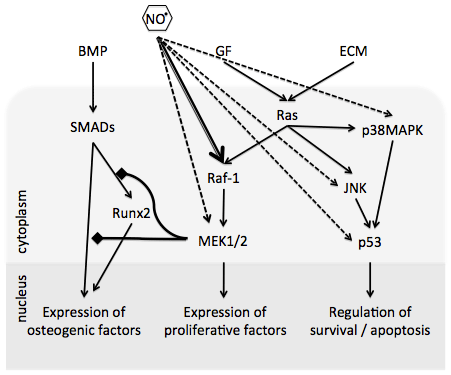
The bone morphogenetic proteins (BMP) induce the phosphorylation of SMADs and facilitate their translocation in the nucleus. The SMADS contribute to expression of the key osteogenic factor Runx2 (left side of the panel). Growth factors (GF) such as fibroblast growth factor and the extracellular matrix (ECM) activate, among other pathways, the small GTPase Ras and the Ras-Rafpathway. Ras controls different signaling pathways, including different MAPkinases and p53 (right side of the panel). BMPs, GFs and the ECM regulate the gene expression required for osteogenic differentiation, proliferation and survival or apoptosis of MSC (thin solid arrows). Depending on the cell, MEK1/2 block the activation and nuclear translocation of SMADs (thick line with rombus), thus inhibiting expression of Runx2 (71). Nitric oxide radicals cause a transiently elevated phosphorylation of MEK1/2, p38MAPK, JNK, and p53 (thin dashed arrows) involved in proliferation, survival and apoptosis. Low NO activates c-Raf (thick arrow), which facilitates the activation of MEK1/2, and may thus interfere with SMAD- and Runx2-dependent regulation of expression in MSC.